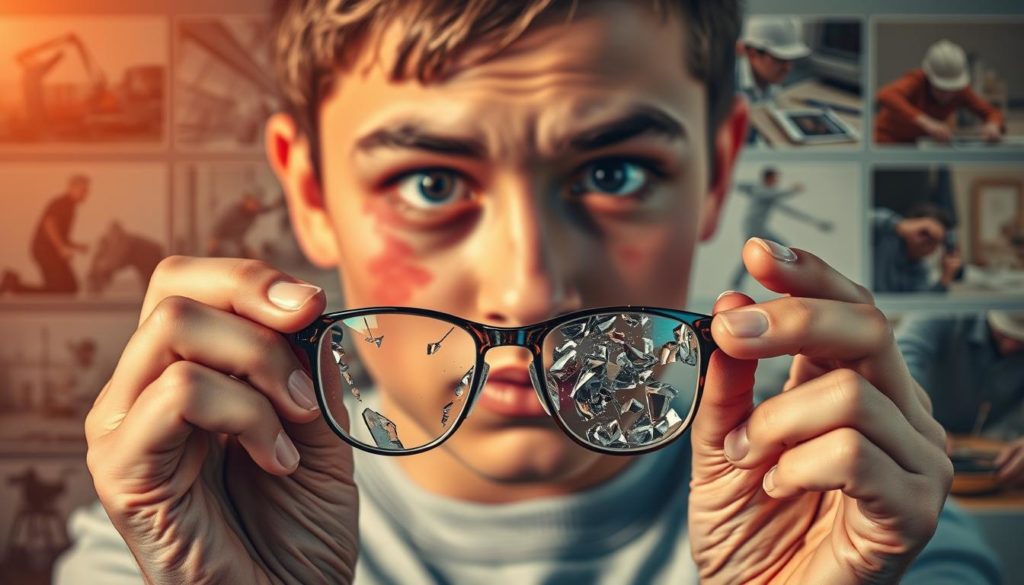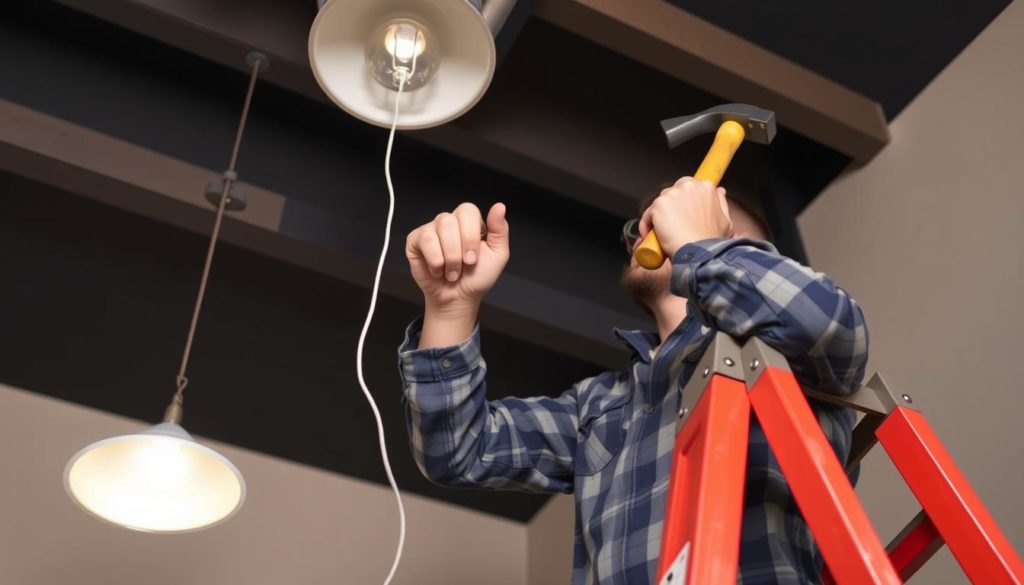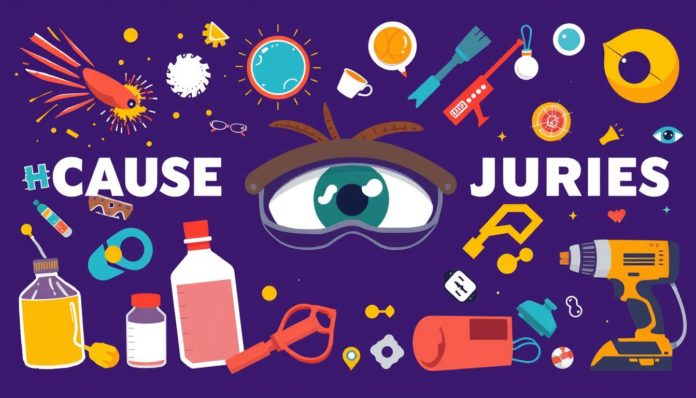Did you know that about 1,000 eye injuries happen at work in the U.S. every day? This fact shows how vital it is to know the causes of eye injuries. We need to protect ourselves at work and at home. Eye injuries can be minor or change your life, causing pain and vision loss.
Many daily activities can lead to eye injuries. This includes dangers at work and fun activities. It’s key to get medical help fast if you get an eye injury to avoid serious damage. Learning about eye injury causes helps protect our sight.
This detailed article will cover the causes, signs, and ways to prevent eye injuries.
Introduction to Eye Injuries
Eye injuries are common and can happen for many reasons. They can come from direct hits, harmful chemicals, or the environment. Knowing why eye injuries happen can help prevent them and get the right treatment.

Eye safety risks are found in many places like work, home, and play. From small annoyances like dust to big injuries needing urgent care, it’s key to know the dangers. Here are some main reasons for eye injuries and the injuries they can cause:
- Physical Contact: Includes injuries from sports, accidents, or falls.
- Chemical Exposure: Caused by cleaning agents, industrial chemicals, or other harmful substances.
- Environmental Factors: Dust, debris, and other airborne particles that can irritate or damage the eyes.
To avoid eye injuries, it’s important to act early. This means wearing eye protection in dangerous places and being aware of risks. By knowing the dangers and how to avoid them, people can keep their eyes safe and lower the risk of injury.
| Cause | Common Injuries | Prevention Tips |
|---|---|---|
| Physical Contact | Cuts, bruises, and fractures | Wear protective gear during activities |
| Chemical Exposure | Burns, redness, and irritation | Use eye protection and handle chemicals safely |
| Environmental Factors | Dry eyes, irritation, and abrasions | Avoid exposure to dust and wear safety glasses |
Common Causes of Eye Injuries
Knowing why eye injuries happen can help us prevent them. Many times, eyes get hurt from direct hits, like punches or blows from sports gear. This is often seen in sports like boxing, football, and hockey.

Work-related accidents also lead to eye injuries, especially in jobs where things fly around. People working with machines or handling materials should be extra careful.
Chemical splashes are another big cause of eye injuries. This can happen at home or at work. Using strong cleaners, pesticides, or chemicals can be dangerous for your eyes.
If you feel a lot of pain, see poorly, or notice damage to your eye, get help right away.
- Damage from physical impacts (e.g., punches, sports equipment)
- Work-related injuries from projectiles
- Chemical splashes and exposure
Physical Impact and Trauma
Eye injuries from physical impact and trauma can be serious. They come from sports or accidental falls. It’s important to know the risks and take steps to protect your eyes.
Sports-Related Eye Injuries
Playing sports like basketball, baseball, and racquet sports without eye protection can be risky. Fast-moving balls and equipment can hurt your eyes. To stay safe, wear protective eyewear.
Using sports eye safety gear like polycarbonate lenses helps a lot. Make sure your eyewear fits well to stay protected during games.
Accidental Falls and Collisions
Accidental falls and collisions are a big risk, especially for older people or those in dangerous places. They can cause eye trauma, cuts, and bruises.
To avoid these, make your home and work safe. Secure loose rugs and keep good lighting. These steps help in preventing falls and collisions.
Following these eye protection tips keeps you safe. It lowers the chance of eye injuries.
Chemical Exposure Hazards
Handling chemicals without proper safety gear can lead to serious eye injuries. Alkalis and acids are especially dangerous, with alkalis causing deeper damage. It’s crucial to know the risks of chemical exposure to keep your eyes safe.
If you get a chemical in your eye, acting fast is key. Start by rinsing with water and then get medical help right away. This can help prevent serious harm.
Always use the right safety gear when handling chemicals, like protective eyewear. This step is key to avoiding eye injuries and keeping your eyes healthy. It’s especially important in places where chemicals are often used.
- Wear protective eyewear at all times when dealing with chemicals.
- Ensure that emergency wash stations are accessible and functional.
- Understand the composition of chemicals you’re working with to anticipate and mitigate hazards.
- Regularly train on eye burn first aid procedures to maintain readiness in case of an incident.
Environmental and Occupational Risks
Work and home can have hidden dangers that can cause eye injuries. Knowing how to protect yourself at work can lower the chance of getting an occupational eye injury. It also helps keep your eyes safe in your daily environment.
Industrial Work Accidents
At work, eyes can get hurt by flying objects, chemicals, or sparks from welding. Following safety rules and wearing the right gear can help avoid these dangers. Always use safety glasses or face shields to protect your eyes from harm.
Home Improvement Projects
Doing projects at home, like drilling or painting, can also be risky for your eyes. To stay safe, always wear protective glasses. This keeps your eyes safe from dust, debris, and chemicals.
| Workplace Hazards | Protective Measures |
|---|---|
| Flying Debris | Wear safety goggles |
| Chemical Splashes | Use face shields, have eyewash stations |
| Welding Sparks | Use welding helmets with face shields |
| Home Improvement Debris | Wear protective glasses |
Impact of Radiation and UV Exposure
Prolonged exposure to radiation and UV rays can harm eye health. These effects can be short-term or long-term, affecting vision and overall eye health. It’s crucial for those often in the sun or near radiation sources to know these risks. We’ll look at how UV exposure affects the eyes, stressing the need for prevention and safety.
Sunburn and Ultraviolet Rays
UV rays from the sun can cause photokeratitis, a sunburn of the eye. Symptoms include redness, irritation, tearing, and temporary vision loss. Wearing sunglasses that block all UVA and UVB rays is key to preventing eye damage. This protects the eyes from immediate harm and reduces long-term risks. It’s best to avoid direct sun exposure, especially during peak UV hours.
Long-Term Effects of Radiation
Long-term UV radiation exposure can cause serious eye conditions like cataracts and macular degeneration. These can greatly reduce vision and even lead to blindness if not caught early. Preventing UV eye damage is crucial, including regular eye checks and using UV-blocking glasses. Research by NCBI shows UV exposure speeds up eye aging and causes oxidative stress, worsening eye health. This highlights the importance of safety measures in work and daily life.
UV radiation isn’t just from the sun; jobs like welding and lab work also pose risks. Using protective eyewear that meets safety standards is vital in these jobs. By taking these steps, people can lower their risk of eye problems, ensuring better eye health.
Symptoms of Common Eye Injuries
Feeling persistent pain in your eye is a big warning sign of an injury. This pain might make your vision disturbance worse, showing a serious problem. Look out for a cut or torn eyelid, which needs quick attention to avoid more harm.
Swelling around your eye is also a common sign. If you see disparities in eye movement or your eyeball protruding, these are serious eye injury signs. Also, if one pupil looks bigger or smaller than the other, it could mean severe damage.
In bad cases, finding blood in your eye or objects in your eye tissue means you need help right away. Other eye trauma symptoms that are urgent include big changes in your vision or suddenly losing your sight.
Here’s a quick summary of eye injury signs and what they mean:
| Key Symptom | Indicator |
|---|---|
| Persistent Pain | Constant discomposure |
| Vision Disturbance | Changes or loss of vision |
| Cut or Torn Eyelid | Visible cuts or tears |
| Swelling | Noticeable puffiness |
| Eye Movement Disparity | Uneven motion between eyes |
| Pupil Size Discrepancy | Different sizes of pupils |
| Presence of Blood | Blood inside the eye |
| Foreign Object | Object lodged in eye tissue |
Preventative Measures for Eye Safety
Eye safety is key in many places, like sports fields and industrial areas. Using good eye injury prevention strategies can lower the chance of eye injuries. This includes wearing the right protective eyewear and handling chemicals safely.
Protective Eyewear Recommendations
Wearing the right eye gear for your activities can really help. This is true for sports, working with power tools, or other risky tasks. Options like sports goggles, safety glasses, and face shields protect your eyes from harm.
These items meet safety standards and let you see clearly. They don’t get in the way of your activities.
Best Practices for Chemical Handling
Handling chemicals safely means following certain rules. Always keep chemicals in their proper containers and label them clearly. When working with chemicals, wear goggles and face shields for protection.
Don’t mix chemicals unless the label says it’s okay. This can cause dangerous splashes or vapors. Following these steps can help avoid accidents and keep your eyes safe.
First Aid for Eye Injuries
Handling an eye injury quickly is key to reducing harm. Emergency eye treatment depends on the injury type. Here’s how to react to different eye traumas.
- Scratches and Small Particles: For minor scratches or if small particles get in the eye, don’t rub it. Flush the eye with clean water or an eyewash solution to clear out debris.
- Blows to the Eye: If you get a blow to the eye, use a cold compress to lessen swelling. Don’t press on the hurt spot.
- Puncture Injuries: With puncture wounds, don’t wash the eye or try to take out any objects. Put a protective shield over the eye and get eye trauma immediate care from doctors.
Learning how to handle eye injuries can greatly help in recovery. Being ready with this knowledge means you can act fast during emergency eye treatment.
Seeking Medical Attention for Eye Injuries
If you get an eye injury, it’s key to see a doctor right away. Some eye injuries might look minor but could get worse if not treated. It’s important to get a professional check-up to know how serious it is and get the right treatment.
Don’t try to treat eye injuries yourself with over-the-counter drugs or by removing objects from your eye. This can make things worse. Always get emergency eye care to avoid serious damage.
An eye injury might not hurt much at first but could lead to losing your sight. So, seeing an ophthalmologist quickly is a must. Getting medical help fast can help prevent more problems and help you heal better.
If you or someone else gets an eye injury, don’t touch or press it. Get professional help right away. Acting fast helps manage the injury and prevents infections or vision loss. For more advice on eye injuries, check out the American Academy of Ophthalmology’s tips.
FAQ
What are common causes of eye injuries?
Eye injuries can come from physical contact, chemical exposure, environmental factors, or work accidents. Knowing these causes helps in treating and preventing them.
How can I prevent eye injuries at home?
To prevent eye injuries at home, always wear protective eyewear when sanding, drilling, or using chemicals. Keep hazardous materials safe and follow chemical handling guidelines to lower risks.
What should I do if I get a chemical splash in my eye?
Flush the eye with water for at least 15 minutes and get medical help right away. Wearing protective eyewear when handling chemicals can prevent such injuries.
Are sports a common cause of eye injuries?
Yes, sports can cause eye injuries from fast-moving objects like balls or rackets. Protective gear can greatly reduce the risk of serious eye damage.
What symptoms indicate that I should seek immediate medical attention for an eye injury?
Look for persistent pain, vision changes, cuts or tears in the eyelids, swelling, or blood or foreign objects in the eye. These signs mean you need urgent medical care.
How can eye injuries be prevented in the workplace?
Use safety gear like masks, goggles, or face shields, and follow safety rules to lower the risk of eye injuries at work.
What are the effects of prolonged UV exposure to the eyes?
Too much UV exposure can cause sunburned eyes and may lead to cataracts and macular degeneration over time. Wearing sunglasses and limiting UV exposure helps prevent these issues.
How can I protect my eyes from radiation?
Use eyewear that blocks UV rays and follow safety rules when working with or near radiation sources.
What are some preventative measures for eye safety?
Wear the right protective eyewear during risky activities, handle chemicals safely, and follow safety rules in sports and work settings to prevent eye injuries.
What should I do if something gets stuck in my eye?
Don’t rub the eye. Try to flush it with water to remove small particles. For serious injuries like punctures, cover the eye with a shield and get emergency help without trying to remove the object yourself.
When should I visit an ophthalmologist for an eye injury?
See an ophthalmologist if you have severe pain, vision changes, or other serious symptoms. Even minor injuries should be checked by a professional to ensure there’s no serious damage.


